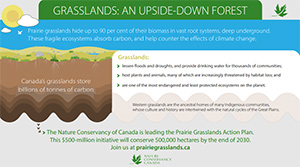Grasslands 101
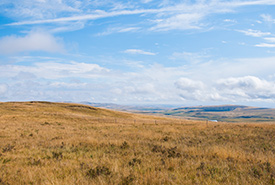
Foothills fescue grasslands, AB (Photo by Leta Pezderic)
What are grasslands?
Grasslands are nature’s unsung heroes, with 90 per cent of their biomass hidden underground in vast and deep root systems. But therein lies their secret powers:
- Grasslands absorb and store billions of tonnes of carbon, keeping it fixed in the soil and helping to counter the effects of climate change.
- They trap and filter precious water resources on the Prairies, lessening both floods and droughts, and provide drinking water for thousands of communities.
- Grasslands are an economic driver of local economies and essential to food security.
- They host an astonishing variety of plants and wildlife, which are increasingly threatened by habitat loss. In fact, bird populations that rely on native grasslands have declined by 90 per cent since 1970.
- Western grasslands are the ancestral homes of many Indigenous communities, whose culture and history are entwined with the natural cycles of the Great Plains.
Where are grasslands found?
Around the world, large areas of grasslands are often found in the interior of continents while pockets of grasslands can also exist in the rain shadows of mountains and dry sand soils. Canada’s Prairie grasslands span Saskatchewan, Alberta and Manitoba, and they are one of the world’s most endangered ecosystems.
Over 80 per cent of Canada’s Prairie grasslands have been lost already, and what remains is at risk of disappearing forever. In the time it takes to watch your favourite television show, the equivalent of 12 CFL-sized football fields will be lost to grassland conversion and human activity. By the end of the day, another 260 football fields will be gone. Every year, 60,000 hectares, or 100,000 football fields, disappear.
The Nature Conservancy of Canada (NCC) is rallying people and communities to conserve and care for this vital, endangered ecosystem. Our Prairie Grasslands Action Plan will conserve more than 500,000 hectares by 2030 — an area six times the size of Calgary, equivalent to what we will lose if we don’t act now to protect the grasslands that remain. It’s a once-in-a-lifetime opportunity. Partnership is at the heart of this plan. NCC is working with local communities, livestock producers and grazing groups, and in collaboration with Indigenous communities, industry and government, to deliver solutions that ensure the grasslands remain a foundation for thriving communities.
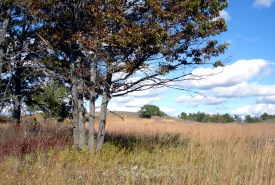
Black oaks on the prairie and savannah, Rice Lake Plains, Ontario (Photo by NCC)
Historically, disturbances such as grazing and fire have helped restore and maintain the health of grasslands. Grazing and fire create a mosaic of habitats across grasslands, providing suitable conditions for a greater variety of plants and animals as some species need shorter grass to survive, while others need longer grass.
Conserving grasslands also has a lasting impact on the health and well-being of Canadians, including providing spaces for recreation and time in nature, which improves mental and physical health. With a science-based approach, we can conserve and care for Canada’s iconic Prairie grasslands. Learn more about this urgent effort and how to join it at prairiegrasslands.ca.
What species live in grasslands?
Grasslands provide habitat for hundreds of species, such as pollinators, swift fox, plains bison and an amazing array of grassland birds. Grassland birds are now one of the most threatened groups of birds in North America due to habitat loss, and includes chestnut-collared longspur, burrowing owl and Baird’s sparrow.
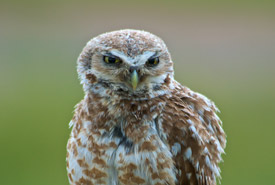
Burrowing owl (Photo by Don Dabbs)
Highlights of some of NCC’s grassland projects include:
In BC, NCC has worked closely with conservation-minded ranchers to protect thousands of acres of the province’s most biodiverse grasslands. With projects in the Okanagan, Thompson-Nicola and Kootenay regions, NCC is helping to ensure grassland habitat will remain intact and undeveloped for migratory birds, rare plants and larger mammals, such as elk and mule deer. The valley-bottoms of the Okanagan are important migratory corridors for large carnivores like grizzly bear and wolverine.
In Manitoba, NCC is working to protect: the tall grass prairie.
The tall grass prairie ecosystem is a type of grassland that once stretched from near present-day Winnipeg all the way south to Texas. Today, the largest intact blocks of tall grass prairie in Canada occur in the Tall Grass Prairie Natural Area. The area supports a variety of habitat types: wet and dry tall grass prairie, marshes and fens, savannah and dense woodlands, riparian (riverbank) areas and rivers.
Thousands of species use these habitats, including many that are listed on national or provincial endangered species lists. Over half of the province of Manitoba's population of the endangered western prairie white-fringed orchid occurs in the Tall Grass Prairie Natural Area.
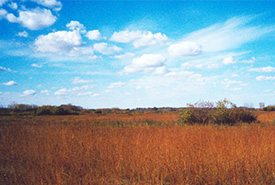
Giant hyssop, tall grass prairie, Manitoba (Photo by NCC)
In Alberta, more than 75 per cent of the province’s original mixed grassland has been converted to tame forage (cultivated fields) and annual cropping. Only 17 per cent of its original fescue grassland remains.
The southeastern Alberta landscape is dominated by grasslands. NCC has identified strategic areas for conservation that have the best potential to support grasslands into the future, including some of the largest intact tracts of native grass in the province. These include the Milk River Ridge, Milk River Basin, Pakowki Lake and Cypress Uplands natural areas.
Southeastern Alberta is an important area for many species that live there. Pronghorn, swift fox, ferruginous hawk, and greater sage-grouse all rely on the grassland habitat in this part of the province. The Pakowki Lake region, designated as an Important Bird Area, supports migratory birds that pass through southeastern Alberta on their way to-and-from breeding and overwintering grounds.
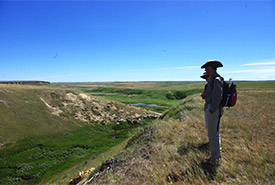
Sandstone Ranch, Milk River Ridge, AB (Photo by NCC)
In Saskatchewan, it is estimated that only 15 per cent of the province’s original native grassland remains intact on the landscape. Thanks to our donors, partners and supporters, NCC has conserved 198,219 hectares of ecologically significant land and water in Saskatchewan. With your support, we will continue to work to protect these remarkable natural areas. An example includes NCC’s Buffalo Pound property, which consists of 866 hectares of native grasslands and seven kilometres of shoreline along the north shore of Buffalo Pound Lake. The lake is also important because it stores the drinking water for a quarter of Saskatchewan’s population, including the cities of Regina and Moose Jaw. The native grasslands help filter the water, trap carbon and hold back flood waters.
For more information on grassland projects, visit prairiegrasslands.ca.


